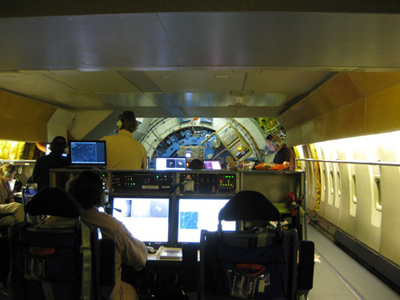The Boeing 747SP converted aircraft SOFIA on a test flight above Waco, Texas
Trinity College Dublin astrophysicist Dr Graham Harper led a team of international scientists recently when they flew aboard the NASA and German Space Agency Boeing-converted plane, Airborne Observatory SOFIA, to observe the supergiant star Betelgeuse during an all-night expedition.
The SOFIA coincidentally is a converted Boeing 747, which has been modified to host a 2.5-metre diameter reflecting telescope that points through an opening in the side of the plane.
SOFIA, an 80pc/20pc partnership with the German Space Agency (DLR), can fly at up to 45,000 feet where it is above 99.8pc of the Earth’s atmosphere water vapour.
This allows astronomers to make far-infrared observations that are otherwise impossible to make from the ground.
Harper flew to Palmdale, California, which is on the edge of the Mojave Desert, on 9 November, to be a lead investigator on the SOFIA Airborne Observatory flight observatory. SOFIA is based at the DFRC-operated Dryden Aircraft Operations Facility in Palmdale.
The aim of the flight mission was to make far-infrared observations of the massive red supergiant star Betelgeuse. This star, also known as Alpha Orionis, is the second-brightest star in the constellation Orion, the eighth-brightest star in the northern night sky, and one of the largest stars ever measured.
The reason why the space agencies took to the skies to observe Betelgeuse is because the star is shedding its extended outer layers and no one is really sure why. It’s a conundrum that has been baffling scientists for more than 50 years.

Scientists on the SOFIA flight mission aboard a converted Boeing 747
Harper, who hails from TCD’s School of Physics, led an international team consisting of Dr Matthew Richter from University of California – Davis; Dr Alexander Brown from University of Colorado at Boulder; and Dr Joanna Brown of the Harvard-Smithsonian Center for Astrophysics.
For his observations on board SOFIA, Harper used the German Receiver for Astronomy at Terahertz Frequencies, or GREAT, an infrared heterodyne spectrometer developed by a team led by Rolf Güsten from the Max-Planck-Institute for Radio Astronomy in Germany.
His investigation called for an examination of the 217 and 163-micron cooling lines of carbon monoxide molecules in the gas flowing away from the red supergiant star.
Gas expelled from the star will be recycled over the next several thousand millennia to form future generations of stars and planets.
SOFIA and GREAT were chosen for this research as the spectral line Harper was observing cannot be detected by any ground-based telescope because it is at a wavelength completely blocked by water vapour in the Earth’s atmosphere.
The SOFIA flight lasted about nine hours and 40 minutes. When the plane reached 43,000 feet, the observations of Betelgeuse commenced with the German Receiver for Astronomy at Terahertz Frequencies (GREAT). Major telescope computer software problems, however, were encountered just after the initial data was collected.
Spectra of Betelgeuse’s warm carbon monoxide
However, the telescope and instrument scientists, together with the pilots, overcame the faulty system and they were able to collect spectra of Betelgeuse’s warm carbon monoxide.
Harper said today that initial inspection of the data reveals that this carbon monoxide emission arises from an outflow travelling at up to 9km per second.
The data is now being analysed by his research group at TCD, including PhD students Sarah Kennelly and Eamon O’Gorman and Neal O’Riain, as part of a Science Foundation Ireland RFP research programme.
The data will be combined with ultraviolet spectra obtained from the Hubble Space Telescope and ground-based infrared spectra.